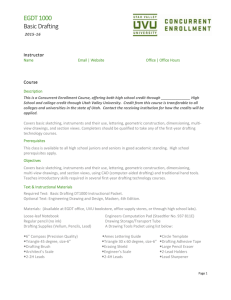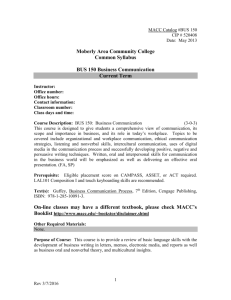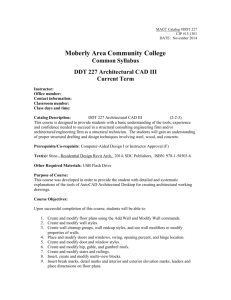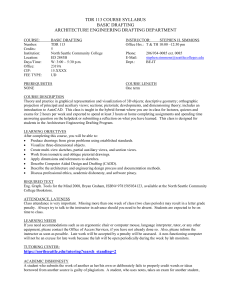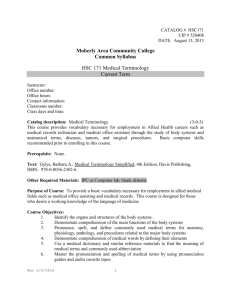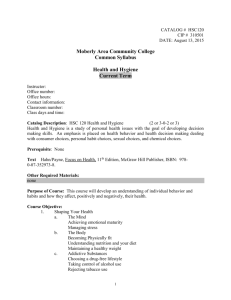DDT 101 Engineering Drawing - Moberly Area Community College
advertisement
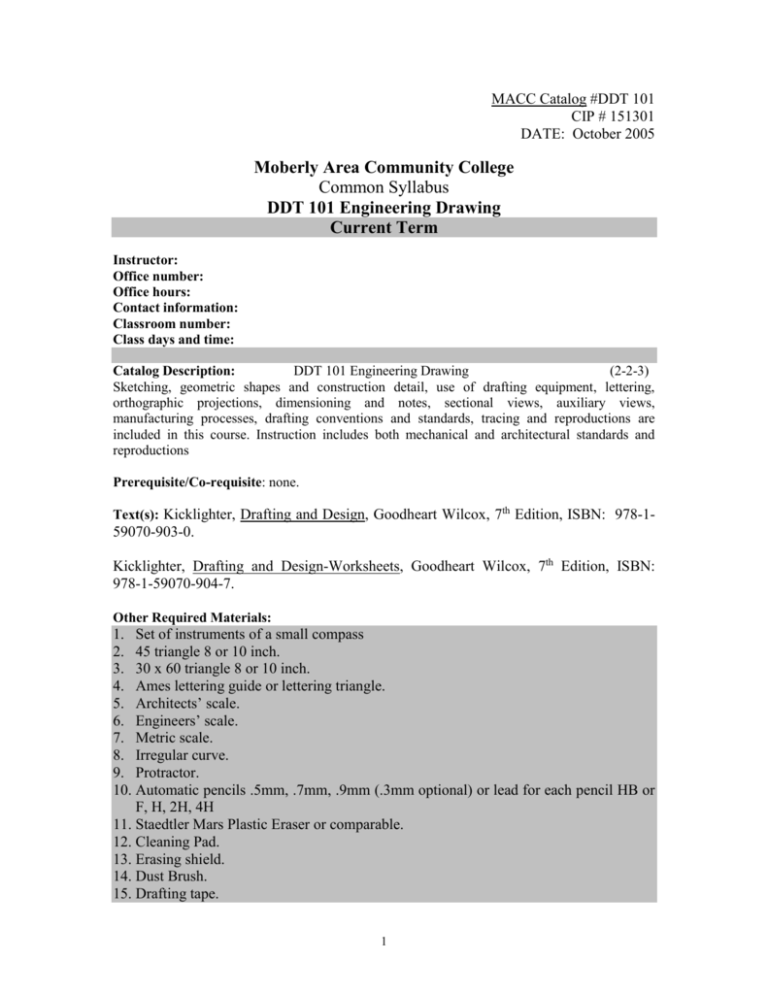
MACC Catalog #DDT 101 CIP # 151301 DATE: October 2005 Moberly Area Community College Common Syllabus DDT 101 Engineering Drawing Current Term Instructor: Office number: Office hours: Contact information: Classroom number: Class days and time: Catalog Description: DDT 101 Engineering Drawing (2-2-3) Sketching, geometric shapes and construction detail, use of drafting equipment, lettering, orthographic projections, dimensioning and notes, sectional views, auxiliary views, manufacturing processes, drafting conventions and standards, tracing and reproductions are included in this course. Instruction includes both mechanical and architectural standards and reproductions Prerequisite/Co-requisite: none. Text(s): Kicklighter, Drafting and Design, Goodheart Wilcox, 7th Edition, ISBN: 978-1- 59070-903-0. Kicklighter, Drafting and Design-Worksheets, Goodheart Wilcox, 7th Edition, ISBN: 978-1-59070-904-7. Other Required Materials: 1. Set of instruments of a small compass 2. 45 triangle 8 or 10 inch. 3. 30 x 60 triangle 8 or 10 inch. 4. Ames lettering guide or lettering triangle. 5. Architects’ scale. 6. Engineers’ scale. 7. Metric scale. 8. Irregular curve. 9. Protractor. 10. Automatic pencils .5mm, .7mm, .9mm (.3mm optional) or lead for each pencil HB or F, H, 2H, 4H 11. Staedtler Mars Plastic Eraser or comparable. 12. Cleaning Pad. 13. Erasing shield. 14. Dust Brush. 15. Drafting tape. 1 16. Other templates and equipment as you deem them beneficial to your work. 17. A 1 ½” three ring binder Purpose of Course: A course designed to introduce the student to drafting and design basics. Course Objectives: Upon successful completion of this course, students will be able to: 1. 2. 3. 4. 5. 6. 7. 8. 9. Understand drafting as a communication, problem solving, and design tool. Properly use drafting equipment. To do freehand lettering. To do freehand sketches. Understand and practice proper line techniques. Understand and utilize proper geometric construction. To produce multiview drawings including orthographic projection. To produce section views of machine parts. Properly dimension machine parts including notation and tolerances. 10. Produce Pictorial drawings 11. Develop auxiliary views of mechanical parts Course Content: Chapter 1: Drafting and the Drafter Chapter 2: Traditional Drafting Equipment and Drawing Techniques Chapter 3: Sketching Lettering and Text. Chapter 4: Basic Geometry Constructions. Chapter 5: Multiview Drawings. Chapter 6: Dimensioning Fundamentals. Chapter 7: Section Drawings. Chapter 8: Pictoral Drawings. Statement to Connect Course with Technical Program Outcome Statement: In compliance with MACC’s General Education outcomes, the student who successfully completes this course will be able to: I. Demonstrate effective written and oral communication; Assessment of Student Learning: Students are assessed on their active participation in class projects and discussions as a team along with their ability to work as an individual. Role will be taken during each class session and student will receive the appropriate grade for participation in group assignments and projects as well as individual work. Participation Chapter reading and review questions Drawings Assigned Exams and Quizzes 10% of grade = 100 points 12% of grade = 120 points 38% of grade = 380 points 40% of grade = 400 points 2 Description of Major Assignment(s)/Project(s): Each chapter of the textbook shall be read and the review questions at the back of each chapter completed, these review questions will be gone over together in class. Drawings will be assigned after the fourth chapter. These drawings will encourage the student to apply commands studied in reading and lecture. Instructor Attendance: Academic Dishonesty: MACC board policy is as follows: “Academic dishonesty by students damages institutional credibility and unfairly jeopardizes honest students; therefore, it will not be tolerated in any form.” Forms of academic dishonesty include but are not limited to the following: violations of copyright law, plagiarism, fabrication, cheating, collusion, and other academic misconduct. Incidents of dishonesty regarding assignments, examinations, classroom/laboratory activities, and/or the submission of misleading or false information to the College will be treated seriously. The procedure for handling academic dishonesty is outlined in the Student Handbook (Policy Handbook M.010). In cases of alleged academic dishonesty, the burden of proof is on the student, not on the instructor. Any student who misses two consecutive weeks of class during a regular sixteen-week semester or the equivalent proportion of class time during a shorter session will be dropped from the class by the instructor unless acceptable justification is supplied. Additionally, any student who misses more than one-fourth of the entire number of in-seat class meetings in a regular 16-week semester or the equivalent proportion of class time during a shorter session, may be dropped from that class by the instructor if, in the opinion of the instructor, the student does not have reasonable opportunity to succeed in the class. A student’s attendance rate will be calculated based upon the first day of the semester (not the student’s date of enrollment in the course). Student attendance must be defined in a different manner for online, hybrid, and virtual courses. Student attendance in these courses is defined as active participation in the course. Online, hybrid, and virtual courses will, at a minimum, have weekly mechanisms for student participation, such as any or all of the following methods: a. Completion of quizzes or exams b. Submission of assignments c. Participation in threaded discussions d. Communication with the instructor A student who does not participate in an online, hybrid, or virtual course for two consecutive weeks will be dropped by the instructor unless acceptable justification is supplied. As with ground courses, a student’s attendance rate in online courses will also be calculated based upon the first day of the semester. If a student does not demonstrate active participation in the online course within the first two weeks (or the equivalent proportion of class time during a short session), the student will be dropped as “never attended.” Simply logging into an online class does not constitute active participation. 3 Students should be aware that their dropping a course and their last date of attendance in the course may impact their financial aid. Tardiness: Any daily quizzes that occur during your absence or if you are tardy will not be able to be taken at a later date. Make-up and late work: Any daily quizzes that occur during your absence or if you are tardy will not be able to be taken at a later date. Late work must be handed in during the next class session. Extra-credit work: Student is allowed extra credit, up to 20 points but not exceeding 20 points. Schedule of Student Assignments/Activities: Week 1 Week 2 Week 3 Week 4 Week 5 Week 6 Week 7 Week 8 Week 9 Week 10 Week 11 Week 12 Week 13 Week 14 Week 15 Week 16 Week 17 - Chapter 1 Chapter 2 Chapter 5 Chapter 5 Chapter 5 continued Chapter 6 Chapter 6 Chapter 8 Chapter 8 continued and midterm Chapter 10 Chapter 10 continued Chapter 11 Chapter 11 continued Chapter 12 Chapter 12 continued Review Final ADA Statement Students who have disabilities that qualify under the Americans with Disabilities Act may register for assistance through the Office of Access and ADA Services. Students are invited to contact the Access Office to confidentially discuss disability information, academic accommodations, appropriate documentation and procedures. For more information, please call either the Moberly office at (660) 263-4100 x 11240 or the Columbia office at (573) 234-1067 x 12120, or visit our web page at http://www.macc.edu/index.php/services/access-office. 4

